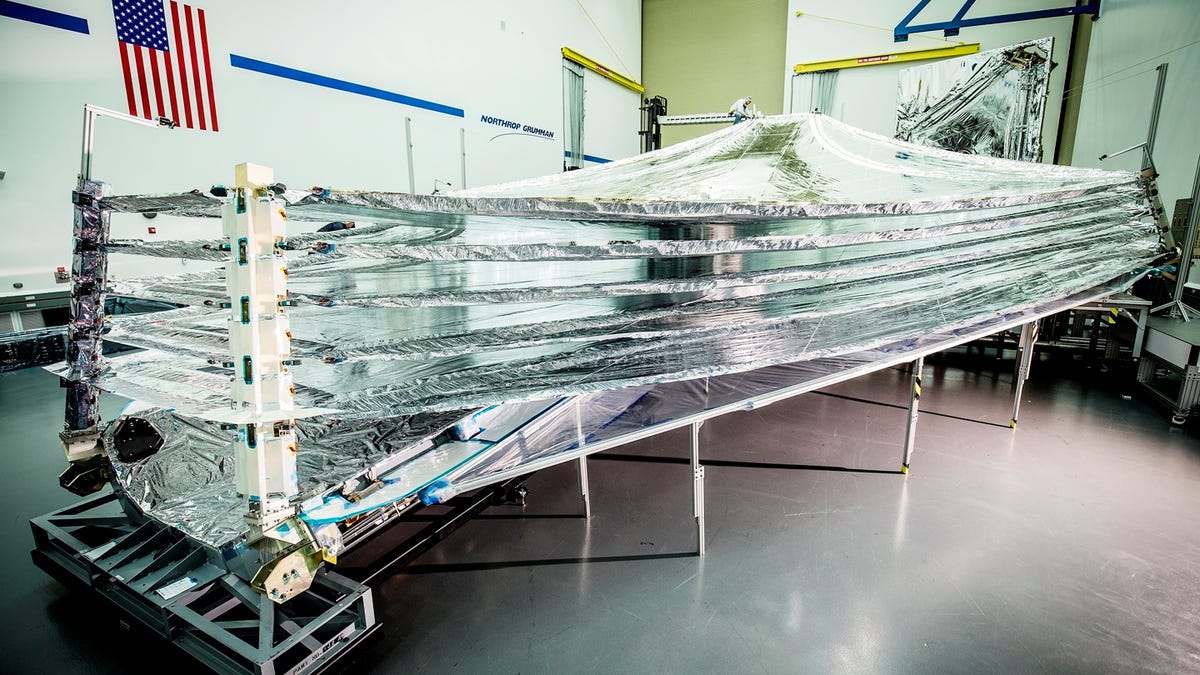NASA James Webb Space Telescope: All sunshield layers are now fully extended
All five layers of the shield are tensioned. Soon, scientists will monitor deployment of the secondary mirror.

The five layers of Webb's sunshield are displayed at a testing facility prior to launch.
Ten days ago, NASA's $10 billion space-telescope upgrade blasted off after 20 years of engineering and a long-awaited countdown. The successful launch earned scientists a breath of relief, but the James Webb Space Telescope's story had just begun.
After launch, Webb began unfurling its intricate folds, with very little room for error. Not long after liftoff, the telescope's solar array and antenna extended. Power and communication had been attained, and ground control greeted the news with an outburst of glee.
Now the team has another win under its belt, as all five layers of Webb's tennis court-size sunshield are tensioned, or tautly pulled out, and the telescope is ready for its next phase: deploying its secondary mirror.
What is the sunshield?
Basically, all of Webb's mechanical operations are connected by a vital prerequisite: The telescope has to be really, really cold. That need for freezing temperatures is rooted in Webb's infrared imaging capabilities, which are integrated with most of its machinery.
A 3D rendering of how James Webb will look in space once fully deployed.
You can learn more about the awesome science of infrared here, but when it comes to the sunshield, you just need to know that infrared imaging works by detecting heat signatures way out in the universe that are invisible to human eyes. That includes signals from faraway galaxies and stars that formed just after the Big Bang.
Once Webb gets the juicy distant star data, we can look at the detected heat patterns to analyze the farthest reaches of the universe, which is why Webb is such a big deal. Scientists can even place the signatures in their rightful spot on the electromagnetic spectrum to figure out how far away their source truly is.
Here's the issue: Nearby objects, visible to human eyes, like the sun, Earth or even Webb itself, also give off heat signatures. The sunshield prevents those unwanted heat signals from flooding Webb's infrared cameras with a sort of noise. That way, the telescope can zero in on what scientists are really after: mysteries lurking several billion light-years away in the cosmos.
Sunshield specs
Each of the sunshield's five layers is extremely thin, measured in matters of microinches. They're all composed of a material called kapton, which has a very high heat resistance, and are coated with aluminum. The first two layers, which will take the brunt of the blaze, also have a treated silicon that reflects the sun's heat.
Each of the sunshield's layers must be precisely spaced with respect to the next.
Every layer is important to keep Webb cool, because as heat radiates through the shield, each kite-shaped film will incrementally reduce the level of heat before it reaches the telescope. The kitelike cutout of the sunshield also directs heat around its perimeter, further protecting Webb.
The shield's seams are made with an ultratough material to guard against rips, it has precisely measured gaps between layers for insulation and includes many other precautions to ensure a perfect amount of thermal stability for Webb as the telescope shares the universe's secrets with us during the next decade.
So, it's a great achievement that all five layers are out and ready to go. Next up, the secondary mirror.

